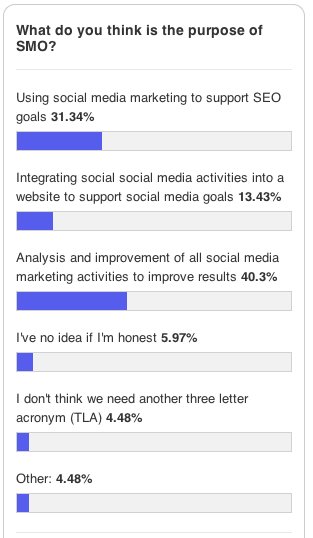and is it something we should be doing?
Social media optimisation or SMO isn't a new term or a new approach, far from it. As the Wikipedia definition of SMO explains, it's been around since 2006 when the search engine marketer Danny Sullivan first used it and Rohit Bhargava developed his 5 rules of SMO which are featured at the end of this post with my suggestions on how to scope SMO activities more broadly.
With many companies now having social media marketing in place, SMO is a logical next step to improve the effectiveness of social media marketing. So I thought it would be interesting to see marketers views on SMO - is it a narrow view about optimising integration with a website, is it mainly related to SEO or is it a broader view?
What do you understand by SMO?
These are the results of the poll - thank you to everyone who voted!
 Well the results were very interesting, if very inconclusive! There was a clear winner where respondents said that SMO relates to analysis and improvement across all social media marketing activities (40%). But not far behind is using Social media to support SEO (31%) - a much narrower scope. I was surprised that integrating social features into a site and encouraging participation from site visitors was rated so low.
Well the results were very interesting, if very inconclusive! There was a clear winner where respondents said that SMO relates to analysis and improvement across all social media marketing activities (40%). But not far behind is using Social media to support SEO (31%) - a much narrower scope. I was surprised that integrating social features into a site and encouraging participation from site visitors was rated so low.
So what can we take from this? I'm going to take a steer from everyone who voted that there is an interest in the broader improvements to social media marketing of which SEO is just one part. It certainly shows the need to scope the aim and activities of SMO within your organisation or to carefully define your agency services.
For reference, the Wikipedia entry describe it as:
"The methodization of social media activity with the intent of attracting unique visitors to website content".
This doesn't help much, but scopes it down specifically to boosting web visits. Rohit doesn't really elaborate on what it is or it's value, instead it's scoped by the rules below which suggest it is about broader customer engagement.
The Fives rules of SMO
If you want to improve SMO I recommend Rohit's 2010 5 NEW Rules of Social Media Optimization (SMO), where he defines these guidelines which I interpret as:
Make sure you follow the �5 rules of SMO:
1. Create shareable content. This is fundamental to social media marketing, so in SMO it's about determining the content that your audience prefers to share across different social media platforms. In Rohit's original post, this activity was about encouraging links: the two go together.
2. Make sharing easy. This is the embedding of buttons and other widgets to encourage sharing, recommending or bookmarking within your site and blog. SMO analyses the best placements, formats and messages to do this.
3. Reward engagement. It's commonplace now to reward "Liking" or "Tweeting" through a promotional or content offer, so this can look at the best offers to do this. Rohit also says this should look at a longer-term of encouraging deeper engagement and conversations.
4. Proactively share content This covers the process and format for sharing beyond your central hub. This can include syndicating articles to other partners or platforms like Slideshare or Scribd. Some also create their own widgets for embedding or sharing on other sites (atomization).
5. Encourage the “mashup”. Rohit says that this is encouraging folks to take and remix your content, so it becomes user generated content. This activity can effectively be built into campaigns.
I think these are really useful for reviewing your approach to integrating social media marketing into a website, but I think there's more to it. So, what's not included in the 5 rules. Well other options which we're looking to test and refine through analytics and AB/multivariate testing on my current project include:
1. Which sharing activities and types of promotions lead to business results, leads, sales or changes in brand preference?
2. Determining how social media can support SEO activities now we know it's a ranking signal and through encouraging backlinks.
3. Preferences of different audiences using different social media platforms to share different type of content and offers.
4. Optimum frequency for initiating sharing.
5. Best methods for identifying influencers and seeding content.
6. Approaches to integrate sharing of content through different social platforms, web, mobile and email channels.
I'd be interested to hear what you understand by SMO, whether you're practicing it and what you have found?! Or other good definitions of SMO and recommended SMO activities you're aware of.







